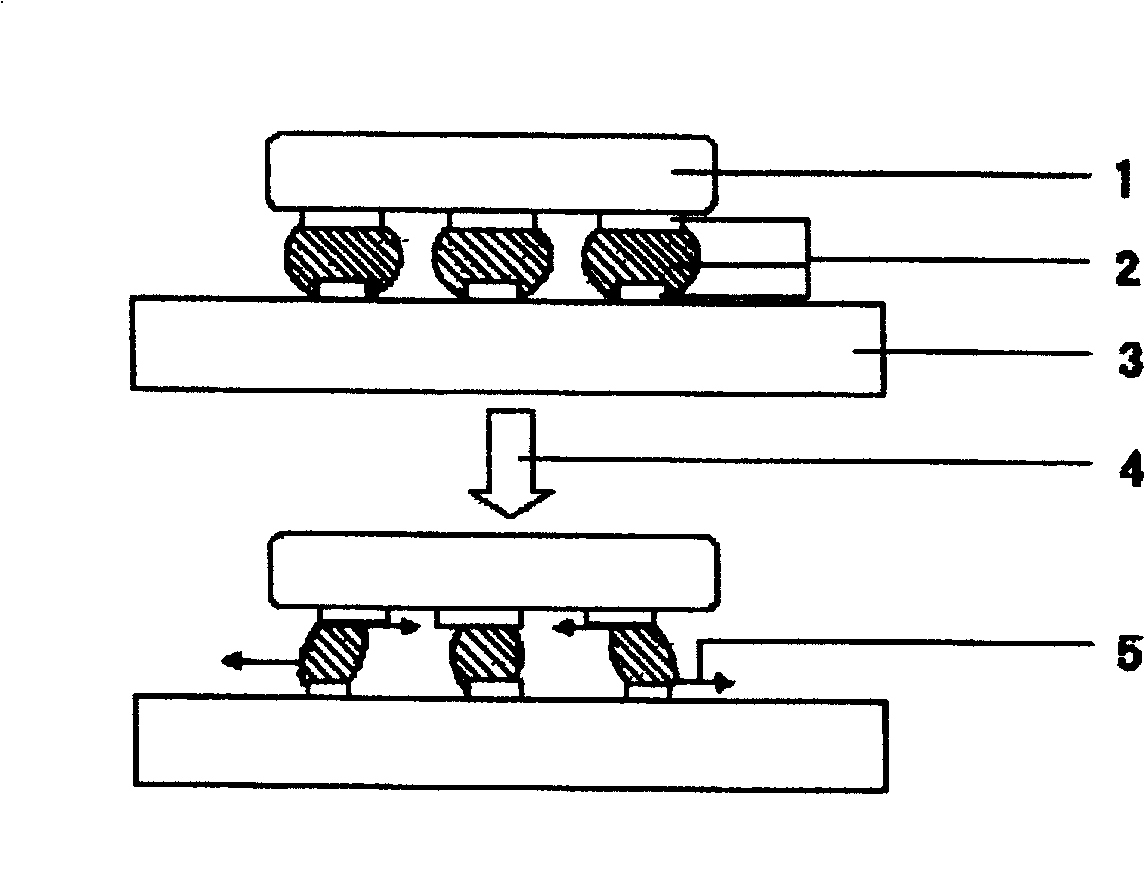Self adaptive lead-free solder component preparation method
A lead-free solder, self-adaptive technology, applied in the direction of welding equipment, welding/cutting medium/material, welding medium, etc., can solve the problems of poor wettability, difficulty in uniform compounding of nickel-titanium shape memory alloy particles, and little effect, and achieve The tight effect
- Summary
- Abstract
- Description
- Claims
- Application Information
AI Technical Summary
Problems solved by technology
Method used
Image
Examples
Embodiment 1
[0015] The tin, silver, and zinc with a purity of 99.99% are heated to 1200°C in a vacuum melting furnace under the protection of argon in a mass ratio of 99.99% by mass ratio of 99.99%, and magnetically stirred at the same time to make the alloy composition uniform, and then the water is condensed and solidified. . Then, the alloy was turned over and reheated to 1200°C to melt, and at the same time, it was magnetically stirred and water-cooled. Repeat this at least five times to obtain button-shaped tin-silver-zinc lead-free solder with a diameter of about 3.0-3.5cm; put the tin-silver-zinc lead-free solder into a crucible under vacuum protection and heat it to 230°C, and quickly pass it through Water quenching produces silver-zinc thermoelastic martensite in the solder, making it have a two-way shape memory effect between 20°C and 100°C, resulting in a tin-silver-zinc adaptive lead-free solder with shape memory properties. The microstructure of the self-adaptive lead-free solder...
Embodiment 2
[0017] Heat tin, silver, zinc, and indium with a purity of 99.99% at a mass ratio of 94.9:3.7:0.9:0.5 in a vacuum melting furnace under the protection of argon to 1300°C, and magnetically stir at the same time to make the alloy composition uniform. , And then the water condenses and solidifies. Then the alloy is turned over and reheated to 1300°C to melt, while being magnetically stirred and water-cooled. Repeat this at least five times to obtain button-shaped tin-silver-zinc lead-free solder with a diameter of about 3.0-3.5cm; put the tin-silver-zinc lead-free solder into a crucible under vacuum protection and heat it to 250°C, and quickly pass it through Water quenching generates silver-zinc thermoelastic martensite in the solder, making it have a two-way shape memory effect between 30°C and 110°C, resulting in a tin-silver-zinc adaptive lead-free solder with shape memory properties. The microstructure of the self-adaptive lead-free solder obtained after preparation is like imag...
Embodiment 3
[0019] The tin, silver, and zinc with a purity of 99.99% are heated to 1350°C in a vacuum melting furnace under the protection of argon in a mass ratio of 96.1:3.4:0.5, and magnetically stirred at the same time to make the alloy composition uniform, and then the water is condensed and solidified. . Then, the alloy was turned over and reheated to 1350°C to melt, and at the same time, it was magnetically stirred and water-cooled. Repeat this at least five times to obtain button-shaped tin-silver-zinc lead-free solder with a diameter of about 3.0-3.5cm; put the tin-silver-zinc lead-free solder into a crucible under vacuum protection and heat it to 255°C, and quickly pass it through Water quenching produces silver-zinc thermoelastic martensite in the solder, making it have a two-way shape memory effect between 35°C and 115°C, resulting in a tin-silver-zinc adaptive lead-free solder with shape memory properties. The microstructure of the self-adaptive lead-free solder obtained after pr...
PUM
 Login to View More
Login to View More Abstract
Description
Claims
Application Information
 Login to View More
Login to View More - R&D
- Intellectual Property
- Life Sciences
- Materials
- Tech Scout
- Unparalleled Data Quality
- Higher Quality Content
- 60% Fewer Hallucinations
Browse by: Latest US Patents, China's latest patents, Technical Efficacy Thesaurus, Application Domain, Technology Topic, Popular Technical Reports.
© 2025 PatSnap. All rights reserved.Legal|Privacy policy|Modern Slavery Act Transparency Statement|Sitemap|About US| Contact US: help@patsnap.com



